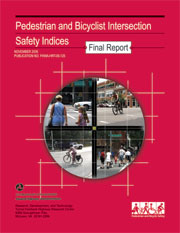Pedestrian and Bicyclist Intersection Safety Indices
Final Report
Source: Pedestrian and Bicycle Information Center (PBIC), Federal Highway Administration (FHWA)

The U.S. Department of Transportation Federal Highway Administration, through research conducted at the UNC Highway Safety Research Center, recently completed the development of the Pedestrian and Bicycle Intersection Safety Indices. These indices are a set of models that enable users to identify intersection crossings and intersection approach legs that should be the greatest priority for undergoing in-depth pedestrian and bicycle safety assessment.
Using observable characteristics of an intersection crossing or approach leg, such as number of lanes, area type, presence of bike lane, type of traffic control, traffic volume, etc., the tool produces a safety index score, with higher scores indicating greater priority for an in-depth safety assessment.
Each leg of an intersection may have different characteristics affecting pedestrian or bicyclist safety, therefore the tool is intended to provide a rating of the safety of an individual crossing (Ped ISI) or approach leg (Bike ISI) rather than evaluating the intersection as a whole.
A practitioner can use the tool to develop a prioritization scheme for a group of pedestrian crossings or bicyclist approaches. This method enables the practitioner to prioritize and proactively address sites that are the most likely to be a safety concern for pedestrians or bicyclists rather than having to wait for analysis following a crash or cluster of crashes at an intersection.
Researchers developed Ped ISI and Bike ISI based on both safety ratings -- expert opinion of the safety of a site -- and observed behaviors -- observed interactions between pedestrians and motorists or bicyclists and motorists. These measures enabled the researchers to use a multifaceted approach to determine the relative safety of a pedestrian crossing or bicycle approach leg.
To develop the Ped ISI and Bike ISI models, researchers studied 68 pedestrian crossings at signalized and unsignalized intersections in Miami, FL, Philadelphia, PA, and San Jose, CA, and 67 bicycle approaches at signalized and unsignalized intersections in Eugene, OR, Gainesville, FL, Philadelphia, PA, and Portland, OR.
Prioritization models were developed based on expert safety ratings and behavioral data. Indicative variables included in the pedestrian safety index model included type of intersection control (signal or stop sign), number of through lanes, 85th percentile vehicle speed, main street traffic volume, and area type. Indicative variables in the bicycle safety models (for through, right-turn, and left-turn bike movements) included various combinations of: presence of bicycle lane, main and cross street traffic volumes, number of through lanes, presence of on-street parking, main street speed limit, presence of traffic signal, number of turn lanes, and others. Through a user-friendly guide, practitioners will be able to use the safety indices to identify which crosswalks and intersection approaches have the highest priority for in-depth pedestrian and bicycle safety evaluations and subsequently use other tools to identify and address potential safety problems.
To view the Tech Brief, visit: http://www.tfhrc.gov/safety/pedbike/pubs/06129/index.htm
To view the User Manual, visit:http://www.tfhrc.gov/safety/pedbike/pubs/06130/




